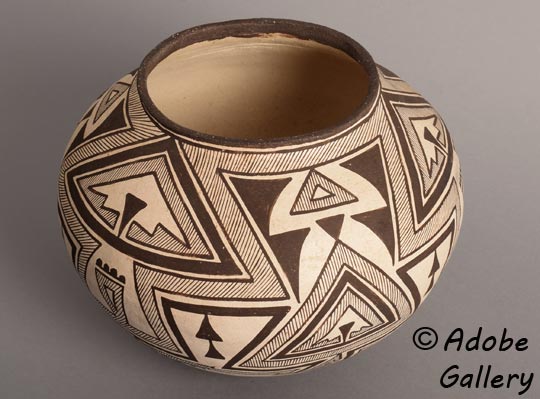Historic Zuni Pueblo Black-on-white OLLA by Tsayutitsa
+ Add to my watchlist Forward to Friend
Forward to Friend
- Category: Historic
- Origin: Zuni Pueblo, SHE-WE-NA
- Medium: clay, pigment
- Size:
9” height x 11-1/4” diameter - Item # C4946.03
- Price: $19500
If someone said to you that it is unequivocal that there were some-albeit only a few-Zuni potters working in the 1920s and 1930s who had abilities equal to those who had been working during the previous century, and further indicated that only two potters were respected enough for their names to be recorded with acquisitions of their works, you would be curious to know who these two women were who were praised so much for their work.
It has been stated that, by 1920, there were only a dozen good potters at Zuni making excellent pottery. Most other potters had been convinced by the new trader, C. G. Wallace, who opened a trading post at the pueblo in 1918, to make small beaded items. He was reluctant to ship pottery so this was his solution. He was purchasing over 600 beaded items daily at one point. Pottery production suffered seriously as a result of Wallace's actions.
Of the dozen good potters who were still making exceptional wares, only two were recognized as the best and those two had their names recorded along with acquisitions of their work — something not done with the other potters. That these two were recognized for their quality product is an indication of their talent.
These two potters have been revealed through significant research by Jonathan Batkin, without which their fame would not be known today. They were Tsayutitsa (ca.1871-1959) and Catalina Zunie (ca.1862-1949). Of Tsayutitsa, Batkin stated "the great master was Tsayutitsa. She is the best potter of the twentieth century." (Batkin, 1987). Another quote "the pottery made by Tsayutitsa includes some of the most spectacular jars ever made at the pueblo." (Lanman & Harlow, 2008)
The OLLA, or water jar, featured in this presentation is unquestionably by Tsayutitsa. This design has been identified as her work. The original inspiration for the design of this jar was a jar seen by Tsayutitsa that originally belonged to Anthropologist Ruth Bunzel which she had acquired while she lived and worked at Zuni between 1924 and 1929. Bunzel donated it to the Indian Arts Fund (the predecessor to the Laboratory of Anthropology collection) in 1925. At some point, Tsayutitsa must have seen the jar and used the design in a jar she entered in the 1929 Santa Fe Indian Fair (predecessor to Santa Fe Indian Market). (Harding, 1983) The Indian Arts Fund purchased that jar and it is still in the School for Advanced Research collection. (Lanmon & Harlow, 2008:439)
In addition to the one from 1929, Tsayutitsa made others. There is one in the Taylor Museum of the Colorado Springs Fine Arts Center, published in Batkin's book on pueblo pottery. (Batkin, 1987). There is not one in the Smithsonian collection because they were not being made at the time of that collection. There may be others not yet published. The only one available on the market is this one. It is an amazing jar with absolutely precise painting as one would expect from such a talented potter.
"Tsayutitsa was also known as Mrs. (Luark) Moomchuti/Lahih. The potter known as Tsayutitsa is one of only two potters of the early 1900s whose name is recognized by many students of Zuni Pueblo pottery. (The other is Catalina Zunie). This recognition is primarily because of the research of Jonathan Batkin, who reported in 1987.
'In the 1920s about a dozen good potters worked at Zuni. Among these was a great master, Tsayutitsa, whose work is unmistakable. Her finest pieces are large and radically shaped, with swollen shoulders, and are decorated with marvelous designs that perfectly accentuate the extreme forms.' (Batkin:1987)
"It has heretofore proven impossible to identify her with certainty and to reconstruct her biographical data. Batkin mentioned that, because her Indian name was difficult to pronounce, many people referred to her as 'Mrs. Milam's mother.' In fact, 'Mrs. Milam's mother' is incorrect; it should have been Mrs. Malani's mother.'
"Reading censuses for variations on the name Tsayutitsa was largely unproductive. Only when we began to search for the name in association with the name Malani were we able to identify her definitely. She was born about 1871, according to tribal records, but census reports list 1862 - 1881. C. G. Wallace staged a celebration for her in 1954, when he said she was 90 years old, putting her birth as 1864. [Lanmon & Harlow, 2008]
Condition: excellent condition
Provenance: this Historic Zuni Pueblo Black-on-white OLLA by Tsayutitsa is from the estate of the client to whom we sold this in 2015
References:
- Biography from The Pottery of Zuni Pueblo by Dwight P. Lanmon and Francis H. Harlow
- Pottery of the Pueblos of New Mexico 1700-1940 by Jonathan Batkin
TAGS: Zuni Pueblo. Catalina Zunie, Southwest Indian Pottery, Tsayutitsa

- Category: Historic
- Origin: Zuni Pueblo, SHE-WE-NA
- Medium: clay, pigment
- Size:
9” height x 11-1/4” diameter - Item # C4946.03
- Price: $19500
Adobe Gallery Recommended Reading
Adobe Gallery Recommended Items
If you are interested in this item, we would also like to recommend these other related items:



